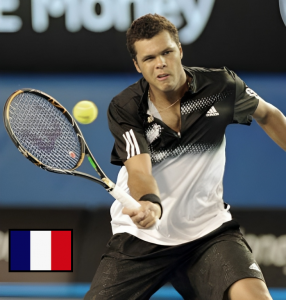Jo-Wilfried Tsonga
Born: April 17, 1985 in Le Mans (Pays de la Loire)
Height: 1.88 m
Plays: Right-handed (two-handed backhand)
The son of a Congolese father, Didier, and French mother, Évelyne (née Rosier). He is an example of someone who entered the luxury tennis saloons out of nowhere, but it’d make sense if we dug deeper into his first steps on the tour… China 2004: the 19-year-old Tsonga, US Open junior champion of 2003, receives a wild card to play in Beijing and  defeats No. 6 in the world Carlos Moyà 6-3, 6-3 in the first round! If someone who is unknown, ranked 209, eliminates a former best player in the world in his first main-level match, there must be something special about him.
defeats No. 6 in the world Carlos Moyà 6-3, 6-3 in the first round! If someone who is unknown, ranked 209, eliminates a former best player in the world in his first main-level match, there must be something special about him.
It’s confirmed more than three years later when Tsonga, participating in just his 16th main-level event, advances to the Australian Open final defeating i.a. Andy Murray & Rafael Nadal, showcasing phenomenal stop-volleys across three sets against the latter.
Between his sensational debut in Beijing and the career-biggest success in Melbourne, he struggled with many injuries (herniated disc & shoulder, moreover back and abdominal problems), because of that, instead of turning into a regular ATP player already in 2005, for two years he’d been drifting between Challengers & Futures events before making a Challenger-ATP transition in 2007, becoming a recognisable face at the beginning of the year in Melbourne, winning a record-tying tie-break vs Andy Roddick on Rod Laver Arena (the American won the match in four sets though).
Mats Wilander belonged to a big group of pundits delighted by Tsonga’s appearance at the Australian Open ’08; the Swede even said that Tsonga would be better than Roger Federer…
Relatively unknown players can hide their weaknesses and I think it was also Tsonga’s case during that amazing Australian fortnight. The following years exposed Tsonga’s backhand hole. Like Marc Rosset a decade earlier, Tsonga occasionally played backhand passing-shots using only one hand. I’d risk a thesis that Tsonga achieved more than you could expect from a guy with his unstable backhand, mainly thanks to his top serve, very good mentality, affirmative attitude.
Tennis is such a psychological game; admittedly, it’s not boxing, you cannot punch your opponent (maybe Tsonga would be good at this with his nickname “Ali”, due to facial resemblance referring to the greatest boxer in history, Cassius Clay), but you can intimidate him, and this is what in my opinion Tsonga was doing very well throughout his career, especially in France (10 of his 18 titles come from French cities, four claimed in Franco-Germanic Metz), feeling the energy of the partisan crowd.
I suppose the vast majority of players knew that in crucial moments playing to his backhand was required, but only the best guys (Novak Đoković, Nadal, Murray) could do this often possessing the required skills. Đoković needed to figure it out – initially Tsonga was one of his toughest opponents, and the great Serb lost to him 5 out of the first 7 meetings including a five-setter at the Aussie Open ’10; their Wimbledon ’11 semifinal changed the history of their encounters and the Serb finished their rivalry at quite overwhelming 17-6. Similar story with Murray who was able to beat Tsonga eight straight times, also including a four-set Wimbledon semifinal – the Brit ultimately won their rivalry 14-2.
Other players were making many mistakes at tight moments or were playing too softly, allowing the Frenchman of African origin, running around his backhand to play big forehands, attack the net, and gain points with crispy volleys or eye-catching overheads; he was enjoying it in an expressive way, which can act as an intimidation factor, causing opponent’s stupid mistakes right after. At tight moments he was really able to raise his game not being afraid to implement the serve-and-volley tactics or accelerating his second serves. There’s no other player like Tsonga, who won three various extremes: the record tie-break (at least as far as majors are concerned, 20/18 against Roddick), the longest deciding 3rd set (25-23 against Milos Raonic), and one of the longest 5th sets in terms of games (19-17 against John Isner).
Tsonga for many years belonged to a group of the “second big 4” consisting of him, David Ferrer, Tomáš Berdych, and Juan Martín del Potro, but only Tsonga among them captured two Masters 1000 shields (Paris ’08 and Toronto ’14). Trivia: in 2011, Tsonga and Federer faced each other eight times – a record. Federer won six of those meetings, including the last one: the final of the “Masters”, yet the Frenchman emerged victorious from their five-set clash at Wimbledon. Tsonga’s career would have felt more fulfilled with a French Open final under his belt, but he fell short twice in the semifinals not facing a Big 4 member (2013, 2015), unable to bring his dream run all the way home in Paris.
Career record: 467–238 [ 244 events ]
Career titles: 18
Highest ranking: No. 5
Best GS results:
Australian Open (runner-up 2008; semifinal 2010; quarterfinal 2009, 13 & 17)
Roland Garros (semifinal 2013 & 15; quarterfinal 2012)
Wimbledon (semifinal 2011-12; quarterfinal 2010 & 16)
US Open (quarterfinal 2011, 15-16)
Davis Cup champion 2017
This entry was posted in
Players. Bookmark the
permalink.



Activity: 2004 – 2022
Five-setters: 16–12 (57%)
Tie-breaks: 231–169 (57%)
Deciding 3rd set TB: 18-14 (56%)
Defeats by retirement: 14
Walkovers given: 3
Longest victory: Wimbledon ’16 (3R)… John Isner 6-7, 3-6, 7-6, 6-2, 19-17… 4 hours 24 minutes
Longest defeat: Davis Cup ’14 (QF)… Peter Gojowczyk 7-5, 6-7, 6-3, 6-7, 6-8… 4 hours 19 minutes
MP matches: 10-11
Two-point away matches: 13-9